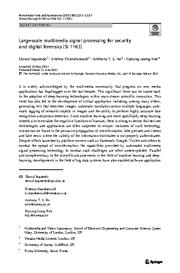A copy of this work was available on the public web and has been preserved in the Wayback Machine. The capture dates from 2021; you can also visit the original URL.
The file type is application/pdf.
Large-scale multimedia signal processing for security and digital forensics [SI 1163]
2021
Multimedia tools and applications
It is widely acknowledged by the multimedia community that progress on new media applications has leapfrogged over the last decade. This significant trend can be traced back to the adoption of deep-learning technologies within main-stream scientific innovation. This trend has also led to the development of critical application including, among many others, generating text that describes images, automatic translation across multiple languages, automatic tagging of semantic objects in images and
doi:10.1007/s11042-021-11108-3
fatcat:g3oxcmd7fre3dpobr27zytff2y

